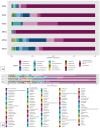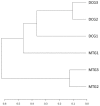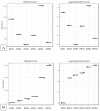Metagenomic Evaluation of Bacterial and Fungal Assemblages Enriched within Diffusion Chambers and Microbial Traps Containing Uraniferous Soils
- PMID: 31489900
- PMCID: PMC6780890
- DOI: 10.3390/microorganisms7090324
Metagenomic Evaluation of Bacterial and Fungal Assemblages Enriched within Diffusion Chambers and Microbial Traps Containing Uraniferous Soils
Abstract
Despite significant technological advancements in the field of microbial ecology, cultivation and subsequent isolation of the vast majority of environmental microorganisms continues to pose challenges. Isolation of the environmental microbiomes is prerequisite to better understand a myriad of ecosystem services they provide, such as bioremediation of contaminants. Towards this end, in this culturomics study, we evaluated the colonization of soil bacterial and fungal communities within diffusion chambers (DC) and microbial traps (MT) established using uraniferous soils collected from a historically contaminated soil from Aiken, USA. Microbial assemblages were compared between the DC and MT relative to the native soils using amplicon based metagenomic and bioinformatic analysis. The overall rationale of this study is that DC and MT growth chambers provide the optimum conditions under which desired microbiota, identified in a previous study to serve as the "core" microbiomes, will proliferate, leading to their successful isolation. Specifically, the core microbiomes consisted of assemblages of bacteria (Burkholderia spp.) and fungi (Penicillium spp.), respectively. The findings from this study further supported previous data such that the abundance and diversity of the desired "core" microbiomes significantly increased as a function of enrichments over three consecutive generations of DC and MT, respectively. Metagenomic analysis of the DC/MT generations also revealed that enrichment and stable populations of the desired "core" bacterial and fungal microbiomes develop within the first 20 days of incubation and the practice of subsequent transfers for second and third generations, as is standard in previous studies, may be unnecessary. As a cost and time cutting measure, this study recommends running the DC/MT chambers for only a 20-day time period, as opposed to previous studies, which were run for months. In summation, it was concluded that, using the diffusion chamber-based enrichment techniques, growth of desired microbiota possessing environmentally relevant functions can be achieved in a much shorter time frame than has been previously shown.
Keywords: diffusion chamber (DC); metagenomics; microbial trap (MT); uranium.
Conflict of interest statement
The authors declare no conflict of interest.
Figures











Similar articles
-
Characterization of Bacterial and Fungal Assemblages From Historically Contaminated Metalliferous Soils Using Metagenomics Coupled With Diffusion Chambers and Microbial Traps.Front Microbiol. 2020 Jun 10;11:1024. doi: 10.3389/fmicb.2020.01024. eCollection 2020. Front Microbiol. 2020. PMID: 32655505 Free PMC article.
-
Metagenomics-Guided Survey, Isolation, and Characterization of Uranium Resistant Microbiota from the Savannah River Site, USA.Genes (Basel). 2019 Apr 28;10(5):325. doi: 10.3390/genes10050325. Genes (Basel). 2019. PMID: 31035394 Free PMC article.
-
Persistent Bacterial and Fungal Community Shifts Exhibited in Selenium-Contaminated Reclaimed Mine Soils.Appl Environ Microbiol. 2018 Aug 1;84(16):e01394-18. doi: 10.1128/AEM.01394-18. Print 2018 Aug 15. Appl Environ Microbiol. 2018. PMID: 29915105 Free PMC article.
-
Metagenomics: Probing pollutant fate in natural and engineered ecosystems.Biotechnol Adv. 2016 Dec;34(8):1413-1426. doi: 10.1016/j.biotechadv.2016.10.006. Epub 2016 Nov 5. Biotechnol Adv. 2016. PMID: 27825829 Review.
-
Polyphasic insights into the microbiomes of the Takamatsuzuka Tumulus and Kitora Tumulus.J Gen Appl Microbiol. 2017 May 12;63(2):63-113. doi: 10.2323/jgam.2017.01.007. Epub 2017 Mar 24. J Gen Appl Microbiol. 2017. PMID: 28344193 Review.
Cited by
-
Arsenic Accumulation in Hydroponically Grown Schizachyrium scoparium (Little Bluestem) Amended with Root-Colonizing Endophytes.ACS Earth Space Chem. 2021 Jun 17;5(6):1278-1287. doi: 10.1021/acsearthspacechem.0c00302. Epub 2021 Jun 3. ACS Earth Space Chem. 2021. PMID: 34308092 Free PMC article.
-
Shotgun metagenomics analysis indicates Bradyrhizobium spp. as the predominant genera for heavy metal resistance and bioremediation in a long-term heavy metal-contaminated ecosystem.Microbiol Resour Announc. 2024 Dec 12;13(12):e0024524. doi: 10.1128/mra.00245-24. Epub 2024 Nov 5. Microbiol Resour Announc. 2024. PMID: 39499072 Free PMC article.
-
Characterization of Bacterial and Fungal Assemblages From Historically Contaminated Metalliferous Soils Using Metagenomics Coupled With Diffusion Chambers and Microbial Traps.Front Microbiol. 2020 Jun 10;11:1024. doi: 10.3389/fmicb.2020.01024. eCollection 2020. Front Microbiol. 2020. PMID: 32655505 Free PMC article.
-
Microbial interaction with and tolerance of radionuclides: underlying mechanisms and biotechnological applications.Microb Biotechnol. 2021 May;14(3):810-828. doi: 10.1111/1751-7915.13718. Epub 2020 Dec 8. Microb Biotechnol. 2021. PMID: 33615734 Free PMC article. Review.
-
Soil Microbial Biogeography in a Changing World: Recent Advances and Future Perspectives.mSystems. 2020 Apr 21;5(2):e00803-19. doi: 10.1128/mSystems.00803-19. mSystems. 2020. PMID: 32317392 Free PMC article. Review.
References
Grants and funding
LinkOut - more resources
Full Text Sources
Research Materials
Miscellaneous

